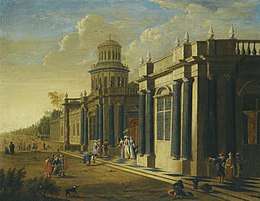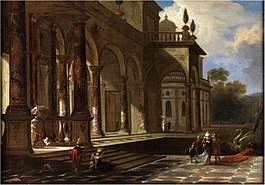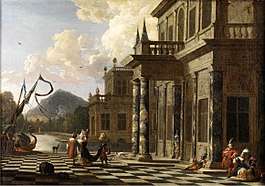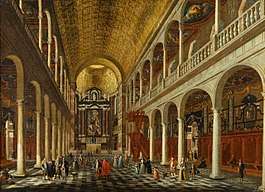Jacob Balthasar Peeters
Jacob Balthasar Peeters, also known as Jacob Peeters or Jacobus Peeters (c. 1655 – after 1721) was a Flemish painter who specialized in architectural paintings depicting imaginary Renaissance and Baroque palaces populated with elegant figures wearing exotic clothes and headgear and shown in theatrical, stage-like postures.[1] Peeters also painted realistic interiors of existing churches with staffage.[2]
_-_Meeting_before_falconry.jpg)
Life
Very little is known about the life and career of Jacob Balthasar Peeters. It is not clear when or where he was born. It is believed he was born in Antwerp around 1655. A Jacobus Peeters was registered in the guild year 1672-72 as an apprentice with the Antwerp Guild of Saint Luke as a pupil of the painter Peter van de Velde. A Jacobus Peeters is also mentioned as a pupil in the guild year 1675-76.[3] It is not clear whether Jacob Balthasar Peeters can be identified with either or both of these pupils.[4]

In the guild year 1688-1689 Peeters became a master in the Guild.[3] Elected in 1695 to serve as dean of the Guild, he preferred to pay the fixed contribution of 360 guilders to be exempted from this charge.[5]
His pupils included Jan-Baptist van Isschot, Jan Baptist van der Straeten, Jan Carel Vierpeyl, Rombaut Bacx and Nicolaas Gillis.[2][3]
The date and place of his death are not known. The artist is usually described as being active from circa 1673 to circa 1721 in Antwerp.[2] A pair of paintings depicting the interiors of the Jesuit Church in Antwerp and signed and dated 1721 are evidence that the artist was still alive in that year.[6]
Work
Jacob Balthasar Peeters was a specialist painter of imaginary Renaissance and Baroque palaces and paintings of existing churches. Peeters would place among these imaginary or existing structures and outdoor settings elegant figures, usually wearing exotic hats and costumes, together with their, often black, pages and with dogs running around.[4]
As was common practice in Antwerp artistic practice of that period, Peeters collaborated with other artists. A pair of paintings depicting Fantastic courtly architecture with staffage (Hampel Munich auction of 25 September 2014, lot 679) constitute a collaborative effort of Peeters and Hendrik van Minderhout.[7] Van Minderhout was a Dutch painter active in Antwerp who often contributed the figures to works by local landscape and perspective painters including Wilhelm Schubert van Ehrenberg.[8] The aforementioned pair of pictures, which were made to be hung next to each other, demonstrate the fantastic, almost surreal, aspects of Peeters' imaginary views. One of the canvases provides an idealized view of a palace with round arched loggias supported by columns and the other of a courtly façade with a portico and a balustrade on top. The buildings are placed respectively on the left and right and disappear in the distance with foreshortening at the rear. Each painting continues onto a view of an idealized park landscape with a large pond on which float pleasure ships with swans as figureheads. The backdrop is a blue sky with brightly lit, white-gray clouds. The artist enlivened the scene by having light fall through the loggia arches, which contrasts with the architectural façade, which is in the shade. Groups of figures in the foreground include ladies and gentlemen who are as fanciful as the architecture. The figures are shown in theatrical, stage-like postures, some engaged in conversation. The ladies have towering hairdos and the gentlemen wear turbans or feathered helmets. A black servant carries the train of one of the ladies' dresses. A guard holding a lance is reclining against the façade of one of the palaces. Some dogs are running among these figures.[7]
 Fantastic courtly architecture with staffage
Fantastic courtly architecture with staffage Fantastic courtly architecture with staffage
Fantastic courtly architecture with staffage
Jacob Balthasar Peeters painted a number of church interiors including of the Jesuit churches of Bruges and Antwerp. This theme was popular in the Low Countries throughout the 17th century. Antwerp artists preferred depicting interiors of high baroque interiors while Dutch artists concentrated on the barren interiors of Protestant churches despoiled of their decorations. In comparison to the earlier church interiors of Flemish and Dutch masters, Peeters' church interiors reflect 18th century artistic preferences through the addition of elegant figures and their attention to detail. One pair of works in the Statens Museum for Kunst in Copenhagen dated 1714 depicts the interior of the Jesuit St. Charles Borromeo Church in Antwerp. A pair of views of the same church were recently on the art market (Lempertz Cologne auction of 19 November 2016). The works created in 1721 show the church in the state before part of its decoration was destroyed by fire on 18 July 1718. In the fire, the interior of the church, including ceiling murals painted by Peter Paul Rubens, was destroyed. Peeters was able to include the lost decorations in these two compositions by using his own compositions which predated the fire such as the works now in the Statens Museum for Kunst.[6]
 Interior of the Jesuit Church in Antwerp
Interior of the Jesuit Church in Antwerp Interior of the Jesuit Church in Antwerp
Interior of the Jesuit Church in Antwerp
Peeters' work shows a strong similarity with other Flemish architecture painters of his time such as Jacobus Ferdinandus Saey and Peeters' own pupil Jan Baptist van der Straeten. The similarities are such that the works of these artists can often not be easily distinguished from each other.[9][10] A painting depicting the Courtyard of Rubens' House in Antwerp (Buckinghamshire County Museum, Aylesbury) was possibly painted by Jacob Balthasar Peeters or Anton Gunther Gheringh, another architectural painter active in Antwerp.[11]
Notes
- De Rubens à Van Dyck: l'âge d'or de la peinture flamande, La Renaissance du Livre, 1994, p. 175 (in French)
- Jacob Balthasar Peeters at the Netherlands Institute for Art History (in Dutch)
- Ph. Rombouts and Th. van Lerius, De liggeren en andere historische archieven der Antwerpsche sint Lucasgilde, Volume 2, Antwerp, 1864, pp. 423, 534, 563, 607, on Google books (in Dutch)
- Olaf Koester, Flemish paintings, 1600-1800, Statens museum for kunst, 2000, p. 179
- Uitgaven der Maatschappij der Antwerpsche bibliophilen, J.-E. Buschmann, 1907, pp. 523-524 (in Dutch)
- Jacobus Balthasar Peeters, Two Interiors of the Jesuit Church in Antwerp at Lempertz
- Jacob Peeters and Hendrik van Minderhout, Gemäldepaar Fantastische höfische Architektur mit Figurenstaffage at Hampel Auctions (in German)
- Frans Jozef Peter Van den Branden, Geschiedenis der Antwerpsche schilderschool, Antwerpen, 1883, p. 876 (in Dutch)
- Jacob Ferdinand Saeys, Elegant figures strolling in a palace garden at Jean Moust
- Attributed to Jacobus Ferdinandus Saey or Jan Baptiste van der Straeten or Jacob Balthasar Peeters, Bordes van een paleis met figuren at the Netherlands Institute for Art History (in Dutch)
- Dr Anne L. Cowe, View through an Architectural Setting: Courtyard at Rubens's House at vads
External links
![]()